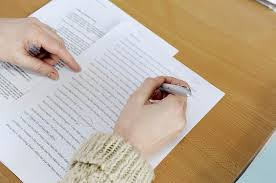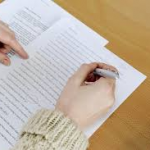
All You Need To Know About Proofreading
 All You Need To Know About Proofreading
All You Need To Know About Proofreading
By Janine Savage. Reposted with permission from Write Divas
When most people ask for a proofread, they expect their manuscript will get a once-over to fix errors and make sure it makes sense. But there’s a lot more to a proofread than simply catching typos and misspelled words. Proofreading is less about the content of the document and more about writing and typographical errors. And before you object, the answer is yes, I know proofreaders fix grammatical errors too, but keep in mind that a proofreader’s job is not to edit. In fact, proofreaders technically aren’t editors. They don’t edit the content of the manuscript. They come in after it has been edited and fix common typos and consistency errors with the format and flow of the text (not the story).
So what exactly does a proofreader do? This article primarily addresses fiction. With that in mind, this list can vary from one publishing house to another and from one freelance editor to another, but for the most part a proofreader will look at the following:
- Proofread for sense
- Common typos and misspelled words such as its/it’s, out/our, you/your, breath/breathe, lead/led, there/their/they’re and your/you’re, to name just a few
- Misspelled or inconsistent spelling of words
- Left out or repeated words
- Illogical, missing, or garbled words and phrases
- Consistency with headers, footers, footnotes, and page numbers
- Consistency with chapter numbers, titles, and subtitles
- Indentation, margins, scene breaks, and other formatting issues
- Typeface, font size, bold, italics, small caps, use of different fonts, and other design elements pertaining to the text
- Consistency with quotation marks in use and style, ellipses, em-dash, en-dash, hyphenation breaks, etc.
- Other formatting or design requirements as put forth by the publisher, if going the traditional route
Depending on the genre or purpose of the book, a proofreader may edit for consistency the format, placement, and use of illustrations, tables, and other supplemental material (not typically part of a fiction manuscript). If the book is fiction, a freelance proofread typically does not include the front and back matter (table of contents, glossary, dedications, forwards, back cover items, etc.) as part of the manuscript proofread. If you are self-publishing, it’s always a good idea to ask for your proofreader’s rates to do these extra items.
Proofreaders do not rely on grammar or spell checkers to do their jobs, and they even check the words they are certain are spelled correctly. Proofreaders are prized for their attention to detail and consistent nature when it comes to their job because they are typically the last set of eyes to go through the manuscript line by line before production. There’s nothing glamorous about proofreading. In fact, it is rather boring at times because of the meticulous nature of the work. The conscientious proofreader, though, can mean the difference between a book riddled with typos and formatting errors and a book that is pleasing to the eye by removing those glitches that may annoy readers and lessen their experience. Alas, even the most diligent proofreader can miss something from time to time. It’s inevitable because no one’s perfect.
Help for Authors & Editors
For your viewing pleasure, I have put together a short list of websites with useful lists to help authors and editors alike improve their work.
- Because most of us don’t have vocabularies the size of Webster’s Dictionary, we tend to misspell the same words. Your Dictionary has put together a list of the 100 Most Often
MispelledMisspelled Words in English. - The Purdue University OWL (Online Writing Lab) has a section on proofreading specially designed to help users do a better job proofreading their own material.
- Wikipedia has a put together a few great lists to get you started, with one each for homophones, repetition, and grammar & misc. This link will take you to a landing page with links to all three >> Wikipedia’s Lists of Common Misspellings.
- Dumbtionary is a site dedicated to misspelled words. Just enter the misspelled word to find the correct spelling. Or if you’re an editor trying to find all the ways a word can be misspelled for a search, enter the correct spelling with a plus sign next to it for a list of common misspellings.
- Find a basic book on grammar and punctuation to refresh your skills. A nice one that doesn’t require an advanced degree in education is The Blue Book of Grammar and Punctuation by Jane Straus.